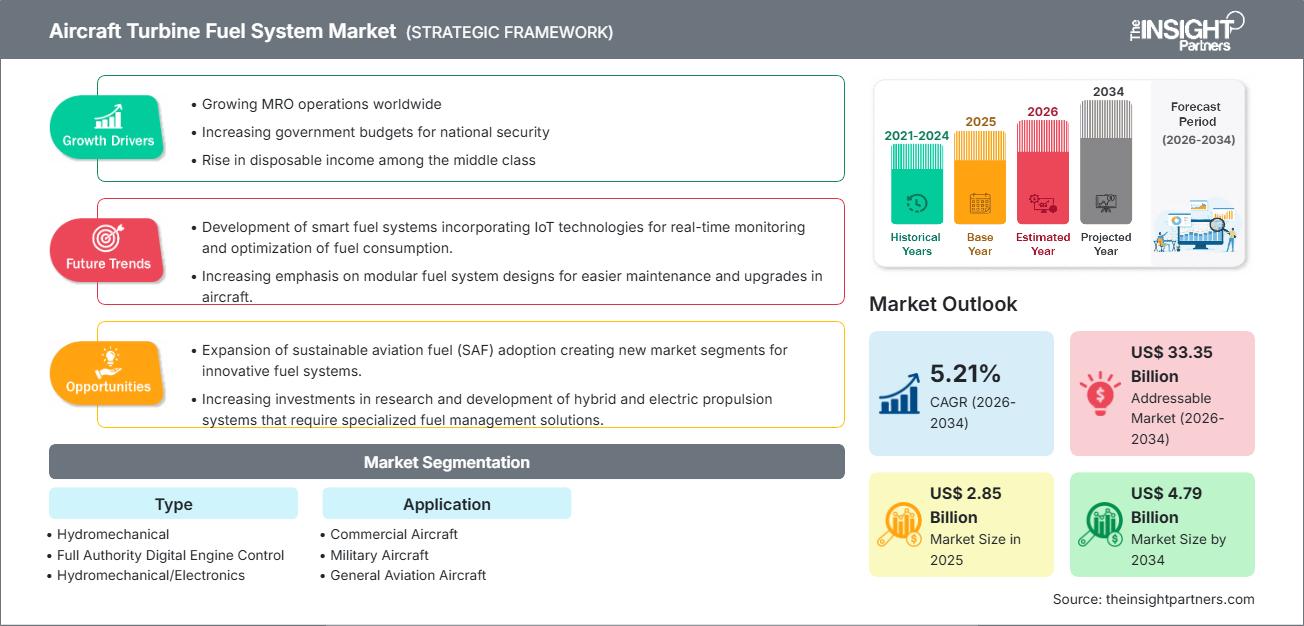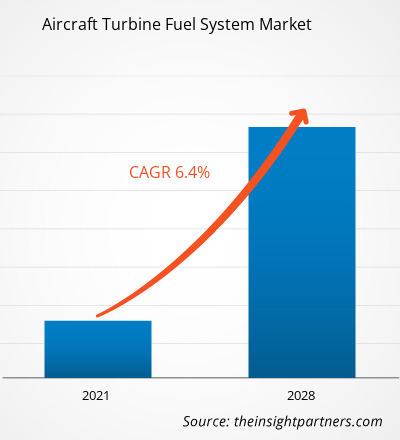항공기 터빈 연료 시스템 시장 규모는 2025년 28억 5천만 달러에서 2034년 47억 9천만 달러에 이를 것으로 예상됩니다. 이 시장은 2026년부터 2034년까지 연평균 5.21%의 성장률을 기록할 것으로 전망됩니다.
항공기 터빈 연료 시스템 시장 분석
항공기 터빈 연료 시스템 시장은 전 세계 항공 여행 증가와 운영 효율성 향상을 위한 야심찬 항공기 현대화 프로그램에 힘입어 꾸준한 성장을 보일 것으로 전망됩니다. 이러한 성장세는 지속 가능한 연료(SAF) 도입, 수소 추진 기술 개발, 엄격한 국제 배출가스 규제 등 글로벌 지속가능성 이니셔티브에 의해 더욱 강화될 수 있습니다. 또한, 환경 규제 준수 및 연료 효율성 향상에 대한 관심은 FADEC(연료 분사 제어 장치) 및 첨단 전자 계량 시스템 분야의 혁신을 촉진하여 상업용 및 군용 항공 분야 모두의 전망을 더욱 밝게 하고 있습니다.
항공기 터빈 연료 시스템 시장 개요
항공기 터빈 연료 시스템은 펌프, 계량 장치, 필터 및 FADEC 시스템을 포함한 매우 중요하고 복잡한 구성 요소 집합체로, 제트 엔진에 연료를 정확하게 저장, 조절 및 공급하는 역할을 합니다. 이러한 시스템은 비행 안전, 최적의 엔진 성능 및 변화하는 환경 기준 준수에 매우 중요합니다. 최신 전자식 및 하이브리드 연료 관리 시스템은 기존의 유압식 장치를 점차 대체하여 탁월한 효율성, 진단 기능 및 새로운 연료 유형에 대한 유연성을 제공함으로써 모든 분야의 차세대 항공기에 필수적인 요소가 되고 있습니다.
이 보고서를 귀하의 요구사항에 맞게 맞춤 설정하십시오.
모든 보고서에 대한 맞춤형 서비스(본 보고서의 일부 내용, 국가별 분석, Excel 데이터 팩 포함)를 무료로 제공해 드립니다. 또한 스타트업 및 대학을 위한 다양한 할인 혜택도 누리실 수 있습니다.
항공기 터빈 연료 시스템 시장: 전략적 분석

-
이 보고서에서 주요 시장 동향을 확인하세요.이 무료 샘플에는 시장 동향부터 추정치 및 예측에 이르기까지 다양한 데이터 분석이 포함됩니다.
항공기 터빈 연료 시스템 시장 동인 및 기회
시장 동인:
- 증가하는 세계 항공 여행 및 항공기 보유 대수 확대: 여객 및 화물 항공 교통량의 지속적인 회복과 성장, 그리고 광범위한 군사 현대화 프로그램으로 인해 신규 항공기 주문에 필요한 안정적이고 고성능의 연료 시스템 공급이 필수적입니다.
- 연료 효율 및 배출가스 제어에 대한 규제 의무: ICAO 및 EU와 같은 기관의 엄격한 국제적 규제로 인해 항공기 제조업체는 연소를 제어하고 환경 영향을 줄이기 위해 정교한 FADEC 및 전자 시스템을 채택해야 합니다.
- 노후 항공기 현대화 및 개조: 구형 상용 및 군용 항공기를 더욱 효율적이고 SAF(지속 가능한 항공 연료 시스템)와 호환되는 최신 연료 시스템으로 업그레이드하려는 움직임이 애프터마켓 부문에서 상당한 수요를 창출하고 있습니다.
시장 기회:
- 지속가능 항공 연료(SAF) 및 수소 추진 시스템 도입: 대체 연료로의 전환은 공급업체에게 SAF 및 극저온 수소를 처리할 수 있는 새롭고 완벽하게 호환되는 연료 계량, 펌핑 및 불활성화 시스템을 개발하고 인증할 수 있는 엄청난 기회를 제공합니다.
- 첨단 FADEC 및 전자식 연료 계량 시스템 개발: 전자 제어 장치 및 하이브리드 시스템에 대한 지속적인 연구 개발을 통해 더욱 정확한 연료 관리, 적응형 엔진 제어 및 연료 소모량 추가 감소를 달성할 수 있습니다.
- 스마트 센서 및 예측 유지보수 기술 통합: 연료 시스템에 센서 기반 진단 및 IoT 연결 기능을 구현하면 사전 예방적 유지보수 계획을 지원하고, 계획되지 않은 가동 중단 시간을 줄이며, 항공사의 전반적인 운영 신뢰성을 향상시킬 수 있습니다.
항공기 터빈 연료 시스템 시장 보고서 세분화 분석
시장 점유율은 다양한 부문에 걸쳐 분석되어 시장 구조, 성장 잠재력 및 새로운 기술 동향을 보다 명확하게 이해할 수 있도록 합니다. 아래는 대부분의 산업 보고서에서 사용되는 표준적인 시장 세분화 방식입니다.
유형별로
- 수력기계
- 완전 디지털 엔진 제어(FADEC)
- 수력기계/전자공학(하이브리드 시스템)
신청을 통해
- 상업용 항공기
- 군용 항공기
- 일반 항공기
지리학별:
- 북아메리카
- 유럽
- 아시아 태평양
- 남미 및 중앙아메리카
- 중동 및 아프리카
항공기 터빈 연료 시스템 시장 지역별 분석
인사이트 파트너스의 분석가들은 예측 기간 동안 항공기 터빈 연료 시스템 시장에 영향을 미치는 지역별 동향과 요인을 자세히 설명했습니다. 이 섹션에서는 북미, 유럽, 아시아 태평양, 중동 및 아프리카, 남미 및 중앙아메리카를 아우르는 항공기 터빈 연료 시스템 시장 세분화 및 지역별 분석도 다룹니다.
항공기 터빈 연료 시스템 시장 보고서 범위
| 보고서 속성 | 세부 |
|---|---|
| 2025년 시장 규모 | 28억 5천만 달러 |
| 2034년 시장 규모 | 47억 9천만 달러 |
| 글로벌 연평균 성장률(2026년~2034년) | 5.21% |
| 역사적 데이터 | 2021-2024 |
| 예측 기간 | 2026-2034 |
| 포함되는 부문 |
유형별로
|
| 대상 지역 및 국가 |
북아메리카
|
| 시장 선도 기업 및 주요 기업 프로필 |
|
항공기 터빈 연료 시스템 시장 참여자 밀도: 비즈니스 역학에 미치는 영향 이해
항공기 터빈 연료 시스템 시장은 소비자 선호도 변화, 기술 발전, 제품 이점 인식 제고 등 여러 요인으로 인한 최종 사용자 수요 증가에 힘입어 빠르게 성장하고 있습니다. 수요 증가에 따라 기업들은 제품 및 서비스 범위를 확장하고, 소비자 요구를 충족하기 위한 혁신을 추진하며, 새로운 트렌드를 활용하여 시장 성장을 더욱 촉진하고 있습니다.

- 항공기 터빈 연료 시스템 시장의 주요 업체 개요를 확인하세요.
항공기 터빈 연료 시스템 시장 점유율 분석 (지역별)
북아메리카
- 시장 점유율: 주요 항공기 제조사들의 존재, 높은 국방비 지출, 그리고 광범위한 개조 프로그램을 지원하는 첨단 MRO(유지보수, 수리 및 정비) 역량에 힘입어 전 세계에서 가장 큰 시장 점유율을 차지하고 있습니다.
- 동향: 예측 정비 기술의 강력한 도입과 FADEC 시스템을 첨단 항공 전자 플랫폼과 통합하는 데 중점을 두고 있습니다.
유럽
- 시장 점유율: 주요 유럽 항공우주 및 방위산업 계약업체의 지원과 지속 가능한 항공 연료(SAF) 및 수소 추진 시스템에 중점을 둔 강력한 연구 개발 활동에 힘입어 상당한 시장 점유율을 확보하고 있습니다.
- 동향: 엄격한 EU 규정을 충족하는 차세대 친환경 연료 시스템 개발을 선도하고 있습니다.
아시아 태평양
- 시장 점유율: 중국, 인도 등 고성장 국가의 대규모 상업용 항공기 확충과 역내 항공 여행 수요 증가에 힘입어 가장 빠르게 성장하는 지역이 될 것으로 예상됩니다.
- 동향: 항공기 유지보수 및 수리(MRO) 시설에 대한 대규모 인프라 투자와 연료 효율이 높은 신형 항공기 모델의 구매 증가.
남미 및 중앙아메리카
- 시장 점유율: 지역 항공사 기종 현대화와 정부의 군수품 조달 프로그램 투자에 힘입어 꾸준히 성장하는 신흥 시장입니다.
- 동향: 지역 항공기 및 일반 항공기를 위한 비용 효율적이고 신뢰할 수 있는 연료 시스템 솔루션에 중점을 두고 있습니다.
중동 및 아프리카
- 시장 점유율: 항공 허브에 대한 대규모 인프라 투자와 최신 항공기 기술을 필요로 하는 주요 국제 항공사들의 확장으로 인해 성장 잠재력이 높은 개발 도상 시장입니다.
- 동향: 다양하고 까다로운 환경 조건에서도 최적의 성능을 발휘하는 첨단 고신뢰성 연료 시스템에 대한 수요가 높습니다.
항공기 터빈 연료 시스템 시장 참여자 밀도: 그 영향 분석
항공기 터빈 연료 시스템 시장은 안전 인증(예: FAA, EASA)과 긴 개발 주기로 인한 높은 진입 장벽 때문에 비교적 과점화되어 있습니다. Eaton, Honeywell, Parker Hannifin, Safran, Woodward와 같은 글로벌 기업들이 주요 항공기 제조업체(OEM)와의 기존 관계를 활용하여 시장을 주도하고 있습니다.
이러한 경쟁 환경으로 인해 공급업체는 다음과 같은 방식으로 차별화를 꾀하게 됩니다.
- 미래 탈탄소화 의무에 발맞춰 차세대 항공기 플랫폼에서 입지를 확보하기 위해 지속가능한 연료 시스템(SAF)과 수소 연료 시스템을 지속적으로 통합합니다.
- 현지 MRO 제공업체 및 방위산업체와의 전략적 파트너십을 통해 고성장 신흥 시장으로 사업을 확장합니다.
- 탁월한 엔진 관리, 진단 및 운영 비용 절감을 제공하는 첨단 FADEC 및 전자 제어 기술 개발.
항공기 터빈 연료 시스템 시장에서 활동하는 주요 기업들
- 이튼
- 허니웰 인터내셔널 주식회사
- 지호스트로이
- 마스콧 장비 회사
- 파커 해니핀 주식회사
- 사프란
- 트라이엄프 그룹 주식회사
- 터빈 연료 시스템 주식회사
- 우드워드 주식회사
면책 조항: 위에 나열된 회사들은 특정 순서대로 순위가 매겨진 것이 아닙니다.
항공기 터빈 연료 시스템 시장 뉴스 및 최근 동향
- 이튼은 EU가 자금을 지원하는 수소 전기 추진 시스템 개발 연구 개발 프로젝트인 HYLENA에 참여한다고 발표했습니다. 이튼은 HYLENA 프로젝트 참여를 통해 이산화탄소 배출이 없는 단거리 및 중거리 비행을 위해 고체 산화물 연료 전지와 터보 기계를 통합하는 데 중점을 두고 있습니다. 또한, 이튼은 지속 가능한 항공 연료(SAF)와 호환되는 첨단 연료 펌프 및 분배 시스템을 계속해서 공급하고 있습니다.
- 하니웰은 UOP eFining™ 기술을 출시하고 SAF 기술 연합을 결성했습니다. 하니웰은 폐메탄올을 eSAF로 전환하여 온실가스 배출량을 최대 88%까지 줄이는 UOP eFining™ 공정을 도입했습니다. 또한, 하니웰은 존슨매티, 기다라에너지, 삼성E&A와 협력하여 바이오매스에서 SAF에 이르는 통합 솔루션을 제공하는 SAF 기술 연합을 설립했습니다.
- 사프란은 BeautHyFuel 프로젝트의 일환으로 수소 연료 터빈 엔진의 지상 시험을 성공적으로 완료했습니다. 이번 수소 동력 터빈 엔진 시험은 사프란에게 중요한 이정표가 되었으며, 지속 가능한 추진 기술에 대한 사프란의 의지를 재확인하는 계기가 되었습니다. 또한, 사프란은 상용 및 군용 항공기를 위한 바이오 연료 호환 연료 분배 및 관리 시스템도 선보였습니다.
- 파커 하니핀은 에어버스 A350 및 코맥 C919 연료 시스템 관련 수십억 달러 규모의 계약을 확보했습니다. 파커 에어로스페이스는 주요 항공기 프로그램에 통합 연료 및 불활성화 시스템을 공급함으로써 포트폴리오를 더욱 다각화하고 첨단 연료 시스템 기술 분야에서 입지를 강화했습니다.
- 트라이엄프 그룹은 허니웰과 장기 전략적 협약을 체결하고 FADEC 개발을 가속화한다고 발표했습니다. 트라이엄프는 허니웰과 협력하여 T55 헬리콥터 엔진과 F124/HTF7000 엔진용 부스트 펌프 및 FADEC 유닛을 생산할 예정입니다. 또한, 차세대 전투기 연료 펌프 및 전자 엔진 제어 장치에 대한 연구 개발도 지속할 계획입니다.
항공기 터빈 연료 시스템 시장 보고서 범위 및 제공 내용
“항공기 터빈 연료 시스템 시장 규모 및 전망(2021~2034)” 보고서는 다음과 같은 내용을 자세히 분석합니다.
- 항공기 터빈 연료 시스템 시장 규모 및 전망 (전 세계, 지역 및 국가별 주요 부문별).
- 항공기 터빈 연료 시스템 시장 동향과 시장 동향(주요 동인, 제약 요인, 핵심 기회 등)을 분석합니다.
- 상세한 PEST 및 SWOT 분석.
- 항공기 터빈 연료 시스템 시장 분석은 주요 시장 동향, 글로벌 및 지역별 시장 환경, 주요 업체, 규제 및 최근 시장 동향을 다룹니다.
- 본 보고서는 항공기 터빈 연료 시스템 시장의 시장 집중도, 히트맵 분석, 주요 업체 및 최근 동향을 포함한 산업 환경 및 경쟁 분석을 제공합니다.
- 상세한 기업 프로필.
- 과거 분석(2년), 기준 연도, CAGR을 포함한 예측(7년)
- PEST 및 SWOT 분석
- 시장 규모 가치/거래량 - 글로벌, 지역, 국가
- 산업 및 경쟁 환경
- Excel 데이터세트
최근 보고서
사용 후기
구매 이유
- 정보에 기반한 의사 결정
- 시장 역학 이해
- 경쟁 분석
- 고객 인사이트
- 시장 예측
- 위험 완화
- 전략 기획
- 투자 타당성 분석
- 신흥 시장 파악
- 마케팅 전략 강화
- 운영 효율성 향상
- 규제 동향에 발맞춰 대응






















 무료 샘플 받기 - 항공기 터빈 연료 시스템 시장
무료 샘플 받기 - 항공기 터빈 연료 시스템 시장